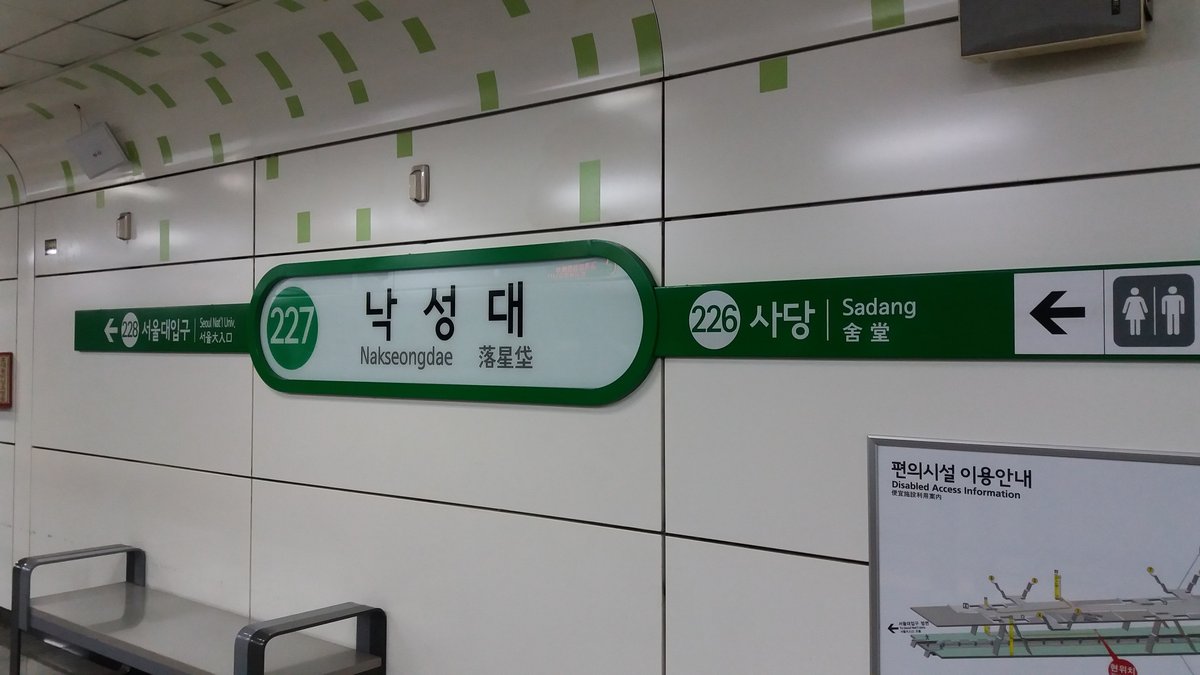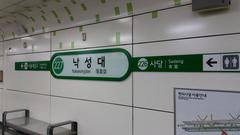
Nakseongdae Station Visiting Hours, Tickets, and Seoul Historical Sites Guide
Date: 15/06/2025
Introduction
Nakseongdae Station, situated in the vibrant Gwanak-gu district of Seoul, is more than just a convenient stop on Seoul Subway Line 2—it is a gateway to one of Korea’s most treasured historical and cultural landmarks: Nakseongdae Park and Anguksa Shrine. The name “Nakseongdae,” translating to “the site where a star fell,” is steeped in legend, marking the birthplace of General Kang Gam-chan (948–1031), a revered military leader whose strategic brilliance during the Third Goryeo-Khitan War preserved the sovereignty of the Goryeo Dynasty.
This guide provides a detailed overview of Nakseongdae’s historical importance, practical information for visiting—including hours, ticketing (free), accessibility, and travel tips—plus highlights of nearby attractions and amenities. Whether you are a history enthusiast, nature lover, or casual traveler, this comprehensive resource will help you experience the best Nakseongdae has to offer.
For up-to-date visitor information, real-time navigation, and immersive audio guides, refer to official Seoul tourism portals and mobile apps such as KakaoMap, Naver Map, and Audiala (Visit Korea, Visit Seoul, Trippose).
Contents
- Introduction
- Historical Background and Significance
- General Kang Gam-chan: Legacy and Monuments
- Nakseongdae Park: Features and Landmarks
- Anguksa Shrine
- Three-Story Stone Pagoda
- Commemorative Trails and Green Spaces
- Visiting Information: Hours, Tickets, and Accessibility
- Getting There: Transportation and Navigation
- Station Facilities and Accessibility
- Nearby Attractions and Activities
- Tips for a Seamless Visit
- Frequently Asked Questions (FAQ)
- Summary and Recommendations
- Sources and Further Reading
Historical Background and Significance
Nakseongdae’s story is inseparable from General Kang Gam-chan, a legendary figure in Korean history. Born at the site where the park now stands, Kang Gam-chan is celebrated for his remarkable victory over invading Khitan forces during the Third Goryeo-Khitan War (1018–1019). The legend of a star falling at his birth endows the area with deep symbolic importance (Visit Korea).
The park and its monuments, established in the 1970s, serve as a living tribute to national resilience and the enduring impact of Kang Gam-chan’s leadership (Korea Tourism Organization).
General Kang Gam-chan: Legacy and Monuments
General Kang’s tactical genius at the Battle of Gwiju is immortalized in Nakseongdae’s monuments. His leadership is not only a source of national pride but also an educational touchstone, with annual commemorative ceremonies and interpretive displays throughout the park (Visit Korea).
Nakseongdae Park: Features and Landmarks
Anguksa Shrine
Constructed in 1974, Anguksa Shrine exemplifies traditional Goryeo wooden architecture. It houses a portrait of General Kang and serves as the focal point for memorial events and educational visits. The shrine’s serene setting offers a contemplative space for visitors (Visit Korea, Trippose).
Three-Story Stone Pagoda
A highlight of the park, the 4.48-meter granite pagoda dates back to the Goryeo Dynasty. Originally marking General Kang’s birthplace, it was relocated in 1973 for preservation and is now a designated cultural asset (Visit Korea, Trippose).
Commemorative Trails and Green Spaces
Nakseongdae Park’s pathways are lined with statues, plaques, and interpretive signs that narrate General Kang’s story. The park’s landscaped gardens, cherry blossoms in spring, and vivid autumn foliage create a picturesque setting for both relaxation and reflection (Trippose).
Visiting Information: Hours, Tickets, and Accessibility
- Park and Anguksa Shrine Hours: Open daily, typically from 5:00 AM to 10:00 PM. Some sources note the shrine’s hours as 6:00 AM to 9:00 PM—always check before visiting, as times may vary by season (Visit Seoul).
- Admission: Entry is free to both the park and shrine.
- Guided Tours: Audio guides are available via apps like Audiala. Occasional guided tours and memorial events may be scheduled—check official tourism sites for details.
- Accessibility: The park features paved, wheelchair-friendly paths, accessible restrooms, and multilingual signage. Some areas may have stairs; consult Naver Map for elevator-equipped station exits (Visit Seoul).
Getting There: Transportation and Navigation
- Subway: Board Seoul Subway Line 2 (Green Line) to Nakseongdae Station (#227). Use Exit 4 for the shortest walk to the park and shrine.
- Bus: Several city buses serve the station. The Gwanak02 bus from Exit 4 stops near Nakseongdae Park and English Village.
- Navigation: Use KakaoMap or Naver Map for precise walking directions, as Google Maps is limited in Korea.
- T-Money Card: Recommended for seamless subway and bus travel. Recharge at convenience stores or station kiosks (Where Tara Went).
Station Facilities and Accessibility
Nakseongdae Station is an underground facility with:
- Operating Hours: 5:30 AM to 12:30 AM
- Ticketing: Automated machines for single-journey tickets and T-money cards; customer service centers available.
- Accessibility: Elevators, escalators, braille maps, tactile paving, and accessible restrooms.
- Other Amenities: Free Wi-Fi, convenience stores, ATMs, and security features (CCTV, emergency call points).
Nearby Attractions and Activities
- Seoul National University: A short distance away, offering campus tours, museums, and events.
- Gwanaksan Mountain: Popular for hiking, with trails starting near the park and leading to scenic temples like Jaunam Hermitage.
- Nam Seoul Museum of Art: Located in the former Belgian Consulate, featuring art exhibitions within walking distance of the station.
- Local Dining: Numerous cafés and restaurants cater to students and visitors, especially near the university (Trippose).
Tips for a Seamless Visit
- Best Times: Visit in spring for cherry blossoms or autumn for colorful foliage.
- Crowds: Weekdays are quieter; weekends and university events may bring more visitors, especially during the annual Inheonjae memorial ceremony.
- Etiquette: Remain respectful at shrines, limit noise, and observe local customs.
- Language: English signage is common, but basic Korean or translation apps are helpful.
- Safety: The area is safe and well-lit, with clean public restrooms.
Frequently Asked Questions (FAQ)
Q: What are the Nakseongdae Park and Anguksa Shrine hours?
A: Generally 5:00 AM–10:00 PM for the park; 6:00 AM–9:00 PM for the shrine. Check ahead for seasonal changes.
Q: Is there an admission fee?
A: No, entry is free.
Q: Are guided tours available?
A: Guided tours may be offered during special events; audio guides are available via mobile apps.
Q: How do I get to the park from Nakseongdae Station?
A: Use Exit 4 and walk approximately 5 minutes.
Q: Is the area accessible for wheelchair users?
A: Yes, with paved paths and accessible facilities, though some routes may include stairs—plan accordingly.
Summary and Visitor Recommendations
Nakseongdae Park and Station together form an accessible, enriching destination that seamlessly blends historical commemoration with natural beauty. Visitors can explore monuments to General Kang Gam-chan, enjoy seasonal landscapes, and access a wide range of facilities and amenities. Proximity to Seoul National University and Gwanaksan Mountain adds depth to any itinerary, while free admission and convenient transit make Nakseongdae a standout among Seoul’s historical sites.
For the most rewarding experience, plan your visit during off-peak hours, use a T-money card for travel, and enhance your exploration with the Audiala app’s audio guides. Stay updated through official tourism channels and make the most of your journey into Korea’s storied past and vibrant present (Visit Korea, Visit Seoul).
Sources and Further Reading
- Visit Korea
- Trippose
- Visit Seoul
- Where Tara Went
- KakaoMap (https://map.kakao.com)
- Naver Map (https://map.naver.com)
- Audiala (link to app store)
Enhance your visit with the Audiala app for immersive audio guides and up-to-date travel tips. Follow us on social media for more on Seoul’s hidden gems!













































































































































































































